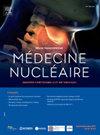Predictive role of 18F-FDG PET/CT in neoadjuvant therapy response in breast cancer with axillary metastasis
IF 0.2
4区 医学
Q4 PATHOLOGY
Medecine Nucleaire-Imagerie Fonctionnelle et Metabolique
Pub Date : 2025-09-12
DOI:10.1016/j.mednuc.2025.07.002
引用次数: 0
Abstract
Objective
The aim of this study is to investigate whether it is possible to predict the response to neoadjuvant therapy (NAT) in axillary lymph node metastasis of breast cancer patients using parameters from 18F-fluorodeoxyglucose positron emission tomography/computed tomography (18F-FDG PET/CT) scans, and to evaluate the correlation of post-NAT PET/CT findings with axillary histopathology results.
Materials and methods
Breast cancer patients with axillary lymph node involvement, who underwent staging and post-NAT PET/CT, followed by surgery or histopathological evaluation, were included. Metabolic and volumetric 18F-FDG PET/CT parameters were analyzed to determine their predictive value for NAT response. Receiver operating characteristic (ROC) curves and Chi-square tests were used for statistical evaluation.
Results
Forty-three breast cancer patients were included in the study. Statistically significant differences were observed between the axillary pathology-negative and positive patient groups for the following variables: post-NAT SUVmax (primary and axilla), ΔSUVmax% (primary and axilla), the largest lymph node diameter on staging PET/CT, and the change in diameter of the same lymph node post-NAT. In the post-NAT axillary lymph node visual evaluation, the sensitivity, specificity, the positive predictive value (PPV), and the negative predictive value (NPV) for detecting metastatic axillary lymph nodes on PET/CT, based on pathology results, were calculated as 81.8%, 66.7%, 72%, and 77.7%, respectively. When a 92.38% threshold value was determined for ΔSUVmax% (axilla), they were 90.9%, 42.9%, 62.5%, and 81.8%, respectively.
Conclusion
Metabolic parameters obtained from 18F-FDG PET/CT can contribute to predicting the treatment response for axillary metastases. 18F-FDG PET/CT provides insights into the necessity of sentinel lymph node biopsy (SLNB) and axillary dissection. However, due to 18F-FDG PET/CT's inability to achieve sufficient sensitivity and specificity, it is unlikely to replace SLNB.
18F-FDG PET/CT在乳腺癌腋窝转移新辅助治疗反应中的预测作用
目的探讨18f -氟脱氧葡萄糖正电子发射断层扫描/计算机断层扫描(18F-FDG PET/CT)参数能否预测乳腺癌腋窝淋巴结转移患者对新辅助治疗(NAT)的反应,并评价NAT后PET/CT表现与腋窝组织病理学结果的相关性。材料和方法纳入经分期和nat后PET/CT、手术或组织病理学评估的乳腺癌腋窝淋巴结受累者。分析代谢和体积18F-FDG PET/CT参数,以确定其对NAT响应的预测值。采用受试者工作特征(ROC)曲线和卡方检验进行统计学评价。结果共纳入43例乳腺癌患者。腋窝病理阴性组与腋窝病理阳性组在nat后SUVmax(原发和腋窝)、ΔSUVmax%(原发和腋窝)、PET/CT分期最大淋巴结直径、nat后同一淋巴结直径变化等指标上差异均有统计学意义。在nat后腋窝淋巴结视觉评价中,基于病理结果计算PET/CT检测腋窝淋巴结转移的敏感性、特异性、阳性预测值(PPV)和阴性预测值(NPV)分别为81.8%、66.7%、72%和77.7%。当确定ΔSUVmax%(腋窝)的92.38%阈值时,它们分别为90.9%,42.9%,62.5%和81.8%。结论18F-FDG PET/CT代谢参数可预测腋窝转移瘤的治疗效果。18F-FDG PET/CT为前哨淋巴结活检(SLNB)和腋窝清扫的必要性提供了见解。然而,由于18F-FDG PET/CT无法达到足够的灵敏度和特异性,因此不太可能取代SLNB。
本文章由计算机程序翻译,如有差异,请以英文原文为准。
求助全文
约1分钟内获得全文
求助全文
来源期刊
CiteScore
0.30
自引率
0.00%
发文量
160
审稿时长
19.8 weeks
期刊介绍:
Le but de Médecine nucléaire - Imagerie fonctionnelle et métabolique est de fournir une plate-forme d''échange d''informations cliniques et scientifiques pour la communauté francophone de médecine nucléaire, et de constituer une expérience pédagogique de la rédaction médicale en conformité avec les normes internationales.

 求助内容:
求助内容: 应助结果提醒方式:
应助结果提醒方式:


